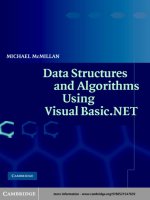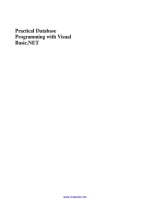Lecture Learning programming using Visual Basic Net – Chapter 4 Performing calculations and manipulating data Expressions
Bạn đang xem bản rút gọn của tài liệu. Xem và tải ngay bản đầy đủ của tài liệu tại đây (70.07 KB, 28 trang )
CHAPTER FOUR
Performing Calculations and
Manipulating Data: Expressions
4- 2
Expressions
• Arithmetic expressions
– To perform arithmetic operations.
• String expressions
– To manipulate string data.
• Logical expressions
– To select an appropriate action.
McGraw Hill/Irwin
©2002 by The McGraw-Hill Companies, Inc. All
rights reserved.
4- 3
Objectives
• Describe the operators and functions used to
create arithmetic, string, and logical expressions.
• Explain why errors occur and how to avoid them.
• Write logical expressions using comparison
operators and logical operators.
McGraw Hill/Irwin
©2002 by The McGraw-Hill Companies, Inc. All
rights reserved.
4.1 Using Expressions, Operators, and
Functions in Visual Basic .NET Statements
4- 4
• An expression tells the computer to manipulate
data.
• The statement tells the computer what to do with
the results of an expression.
• Expressions are composed of values, operators,
and functions.
McGraw Hill/Irwin
©2002 by The McGraw-Hill Companies, Inc. All
rights reserved.
4.1 Using Expressions, Operators, and
Functions in Visual Basic .NET Statements
(cont.)
• Statements
– Perform various tasks
• Evaluate expressions one at a time.
• Carry out tasks specified in expressions.
McGraw Hill/Irwin
©2002 by The McGraw-Hill Companies, Inc. All
rights reserved.
4- 5
4.1 Using Expressions, Operators, and
Functions in Visual Basic .NET Statements
(cont.)
4- 6
• Expressions
– Single values or a combination of values,
operators, and/or functions that reduce to a single
value.
– Evaluated by calculation or manipulation.
– Result in numeric, string, or Boolean values.
McGraw Hill/Irwin
©2002 by The McGraw-Hill Companies, Inc. All
rights reserved.
4.1 Using Expressions, Operators, and 4- 7
Functions in Visual Basic .NET Statements
(cont.)
• Operators
– Symbols for a common operations such as
addition or multiplication.
– Most operators are binary operators.
McGraw Hill/Irwin
©2002 by The McGraw-Hill Companies, Inc. All
rights reserved.
4.1 Using Expressions, Operators, and
Functions in Visual Basic .NET Statements
(cont.)
• Functions
– Descriptive names that specify a more complex
operation than that performed by an operator.
– Names are always followed by parentheses.
– The value between the parentheses is called the
argument.
– The resulting value is called the return value.
McGraw Hill/Irwin
©2002 by The McGraw-Hill Companies, Inc. All
rights reserved.
4- 8
4.1 Using Expressions, Operators, and
Functions in Visual Basic .NET Statements
(cont.)
• More Complicated Expressions
– Operators and functions can be composed into
complicated expressions.
– A function’s argument may be complex.
• Ex. X = Math.Sqrt(10 + Math.Sqrt(Y + 29))
McGraw Hill/Irwin
©2002 by The McGraw-Hill Companies, Inc. All
rights reserved.
4- 9
4.1 Using Expressions, Operators, and 4-10
Functions in Visual Basic .NET Statements
(cont.)
• Expressions as a Part of Statements
– An expression is always a part of a statement.
• Ex. Z = Math.Sqrt(X + 2 + Y) + Math.Sqrt(4)
McGraw Hill/Irwin
©2002 by The McGraw-Hill Companies, Inc. All
rights reserved.
4.2 Arithmetic Expressions
• Arithmetic operators and functions must be
written according to Visual Basic .NET syntax.
McGraw Hill/Irwin
©2002 by The McGraw-Hill Companies, Inc. All
rights reserved.
411
4.2 Arithmetic Expressions (cont.)
• Arithmetic Operators and Operator Precedence
– Arithmetic operations must adhere to the
following order:
1. Exponentiations
2. Unary negations
3. Multiplications and Divisions
4. Integer divisions
5. Modulus operations
6. Additions and Subtractions
McGraw Hill/Irwin
©2002 by The McGraw-Hill Companies, Inc. All
rights reserved.
412
4.2 Arithmetic Expressions (cont.)
• Integer Division
– Calculates the number of times one integer goes
into another, discarding the reminder.
– Mod calculates the reminder when one integer is
divided by another.
McGraw Hill/Irwin
©2002 by The McGraw-Hill Companies, Inc. All
rights reserved.
413
4.2 Arithmetic Expressions (cont.)
• Arithmetic Functions
–
–
–
–
–
–
–
Math.Sqrt()
Math.Abs()
Math.Sign()
Fix()
Math.Exp()
Math.Log()
Rnd()
McGraw Hill/Irwin
©2002 by The McGraw-Hill Companies, Inc. All
rights reserved.
414
4.2 Arithmetic Expressions (cont.)
• Type Conversion Functions
– A number of functions will convert values from
one type to another.
•
•
•
•
CBool()
CDbl()
CDec()
CInt()
McGraw Hill/Irwin
CLng()
CShort()
CSng()
CStr()
©2002 by The McGraw-Hill Companies, Inc. All
rights reserved.
415
4.2 Arithmetic Expressions (cont.)
• Avoiding Arithmetic Errors
– We must write arithmetic expressions carefully.
– We must avoid certain pitfalls.
– Overflow Errors
• Occur when computer attempts to store a number
that is too large for its data type.
– Roundoff Errors
• Occur when floating-point values or certain
variables are used in a program.
McGraw Hill/Irwin
©2002 by The McGraw-Hill Companies, Inc. All
rights reserved.
416
4.2 Arithmetic Expressions (cont.)
– Problems Caused by Limited Significant Digits
• Limitations on the number of significant digits.
• Digits may be loss at run time.
McGraw Hill/Irwin
©2002 by The McGraw-Hill Companies, Inc. All
rights reserved.
417
4.3 String Expressions
• Manipulate strings using string operators and
functions.
– String Operators
• & is the only string operator in Visual Basic .NET.
• Joining two string values is called concatenation.
– Functions Used with Strings
• Format()
– Converts a numeric value to a string and formats it.
• Left(), Right(), and Mid()
– Selects specific character(s) in a string.
McGraw Hill/Irwin
©2002 by The McGraw-Hill Companies, Inc. All
rights reserved.
418
4.3 String Expressions
419
– Functions Used with Strings (cont.)
• StrConv()
– Converts a string into a new string using conversion
rules.
• LTrim(), Rtrim(), and Trim()
– Remove leading and trailing spaces.
• Len()
– Determines the number of characters in a string.
• Space()
– Indicates the number of spaces to create.
McGraw Hill/Irwin
©2002 by The McGraw-Hill Companies, Inc. All
rights reserved.
4.3 String Expressions
– Functions Used with Strings (cont.)
• InStr()
– Conducts a string search.
• Asc() and Chr()
– Access values in the ANSI table.
• Replace()
– Perform a search and replace routine.
McGraw Hill/Irwin
©2002 by The McGraw-Hill Companies, Inc. All
rights reserved.
420
4.4 The Try/Catch Block Revisited
• Used to detect and respond to error conditions.
• Can handle multiple error conditions.
McGraw Hill/Irwin
©2002 by The McGraw-Hill Companies, Inc. All
rights reserved.
421
4.6 Logical Expressions
422
• Used to select an action from alternative actions.
• Results in a True or False answer to a test.
• Also known as Boolean expressions.
– Comparison Operators
•
•
•
•
•
•
<
<=
>
>=
=
<>
McGraw Hill/Irwin
©2002 by The McGraw-Hill Companies, Inc. All
rights reserved.
4.6 Logical Expressions (cont.)
423
– Comparison of Strings
• Strings are ranked alphabetically.
– Logical Operators
• Combine simple logical expressions to create more
complex expressions.
• Common operators are Not, And, and Or.
McGraw Hill/Irwin
©2002 by The McGraw-Hill Companies, Inc. All
rights reserved.
4.6 Logical Expressions (cont.)
– Logical Functions
• Common ones are IsNumeric() and IIf().
• IsNumeric() is True if the argument is a valid
number.
• IIf() chooses between two alternate paths.
McGraw Hill/Irwin
©2002 by The McGraw-Hill Companies, Inc. All
rights reserved.
424
Chapter Summary
• Expressions are part of a statement.
• Expressions can be numeric, string, or logical.
• Expressions consist of constants, variables,
operators, and functions.
• An operator is a symbol that specifies a simple
operation.
McGraw Hill/Irwin
©2002 by The McGraw-Hill Companies, Inc. All
rights reserved.
425









